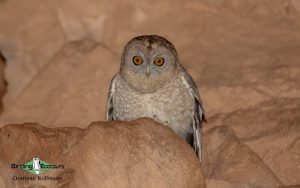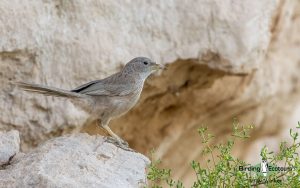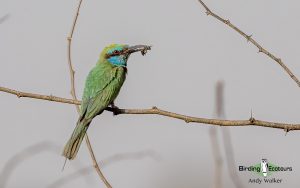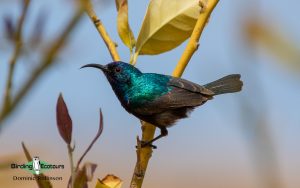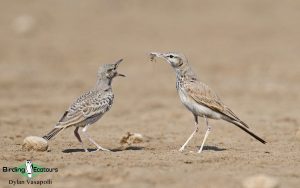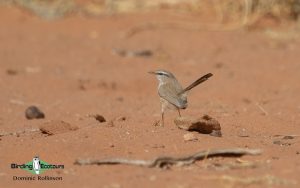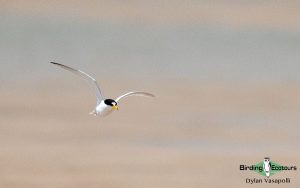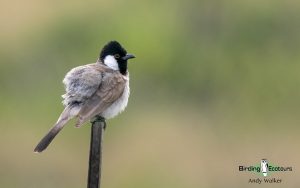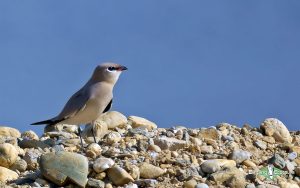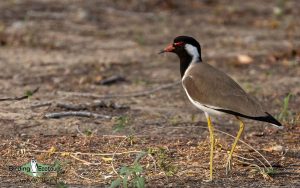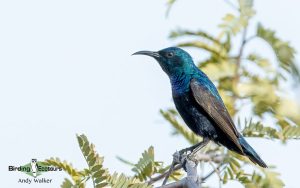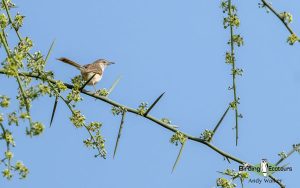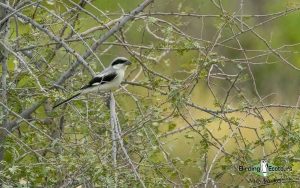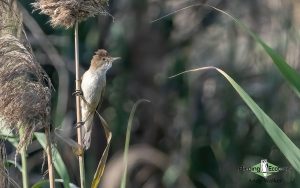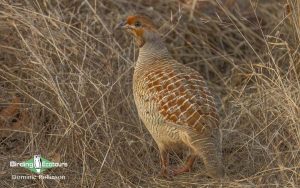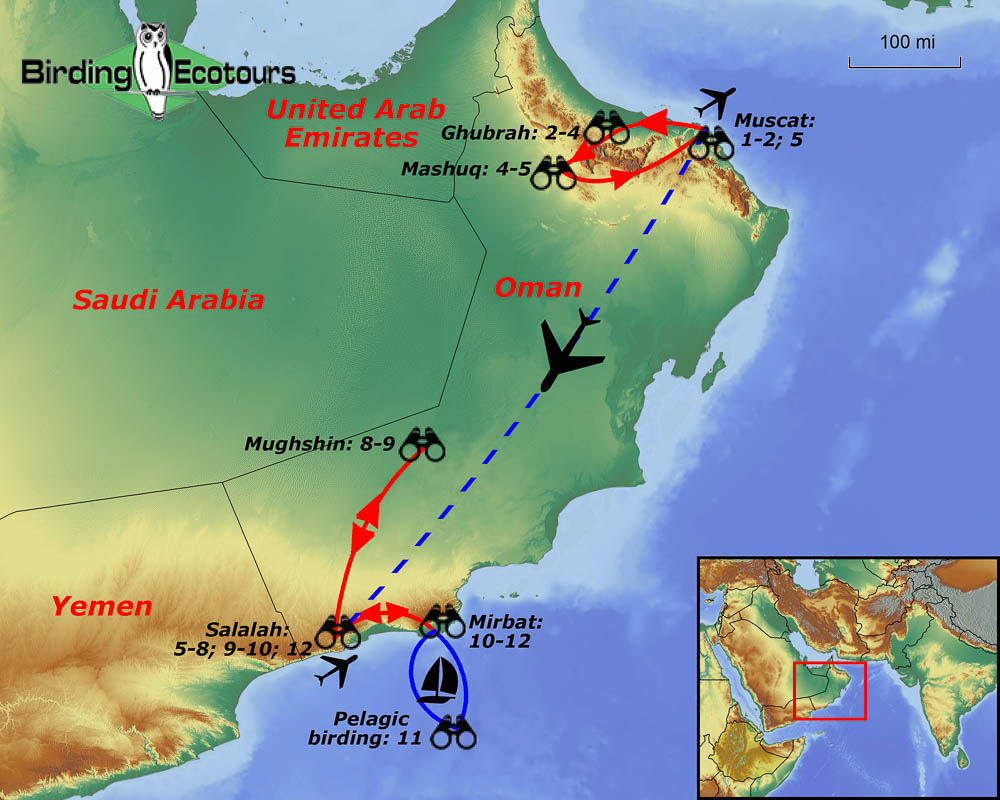Oman Birding Tour: Endemic Birds of the Arabian Peninsula
Oman Birding Tour – Endemic Birds of the Arabian Peninsula
November 2025/2026
Oman is well-known among international birdwatchers, and for good reason. This peaceful country offers some of the best birdwatching in the Arabian Peninsula, with a high diversity of species and many specials possible in a relatively short timeframe. The tour begins in northern Oman, starting in the capital, Muscat, and then travels west into the breathtaking heights of the Al Hajar and Jebel Akhdar mountains. We finish the tour in coastal Salalah, the most southerly city in Oman, from where we venture into Oman’s true desert interior, a stark contrast to the diverse and unexpectedly lush habitats around Salalah. Throughout the journey, we will target species endemic to the Arabian Peninsula, as well as rare seabirds, and interestingly, African species near the eastern edge of their range, and many European and Asian migrants.
Some of the key targets on this varied tour include the enigmatic Omani Owl and Forbes-Watson’s Swift, along with many species endemic to the Arabian Peninsula, such as Arabian Partridge, Arabian Scops Owl, Arabian Eagle-Owl, Desert Owl, Arabian Green Bee-eater, Arabian Babbler, Tristram’s Starling, Arabian Wheatear, Arabian Sunbird, Yemen Serin, and Arabian Golden-winged Grosbeak. We also seek range-restricted species like Sand Partridge, Arabian Warbler, and Palestine and Nile Valley Sunbirds, as well as wintering migrants like Plain Leaf Warbler and Eversmann’s Redstart to name just a few. During our Oman birding tour, we will explore the foothills and heights of several different mountain ranges, from the rugged Al Hajar and Jebel Akhdar mountains in the north, with their dramatic canyons and ancient terraced farms, to the Dhofar mountains in the south, where mist-covered hills and unique vegetation create a striking change in the scenery. Due to the Khareef monsoon season, the Dhofar slopes are transformed into a lush, green oasis for part of the year, creating a home for a unique bird community of Arabian, African, and Asian species.
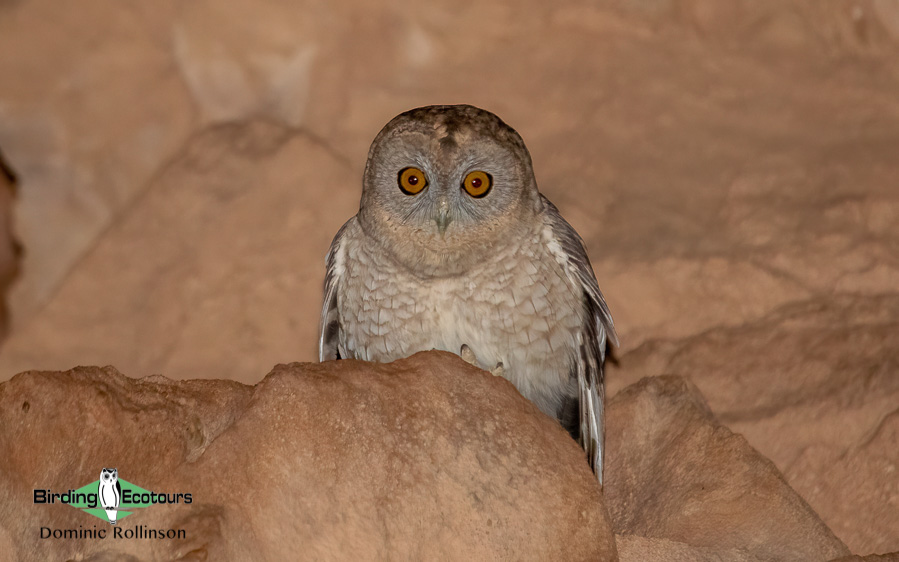
Away from the mountains and hillsides, we will experience the mesmerizing beauty of Oman’s ever-changing deserts, where within oases and alongside towering sand dunes, we will search for desert species like the highly sought monotypic Grey Hypocolius, as well as Sand Partridge, Chestnut-bellied, Spotted, and Crowned Sandgrouse, Greater Hoopoe-Lark, and Hume’s, Hooded, Variable, and Persian Wheatears. Along the southern coast, we will explore rich coastal habitats teeming with shorebirds, and embark on a pelagic boat trip out of Mirbat, famous for the abundance of seabirds, where we hope to see range restricted Socotra Cormorant, Saunders’s and White-cheeked Tern, Sooty Gull, Persian Shearwater, and Jouanin’s Petrel, plus marine mammals such as Sperm Whale and Spinner Dolphin. Oman has long been a popular eco-tourism destination, which means we can enjoy comfortable accommodations and great food throughout, from charming guesthouses nestled in the mountains to luxurious resorts in the south. This will be an unforgettable birding adventure, offering a chance to experience Oman’s incredible wildlife and stunningly diverse landscapes.
Although Crab-plover, Sociable Lapwing, and Variable Wheatear are targets on our Oman birding tour, these species can be tough to find and are all much easier to see in the Dubai area. For those interested, we can arrange a two-day stopover in the United Arab Emirates (UAE) to try for these three species, along with the impressive Pharaoh Eagle-Owl. Please inquire on booking.
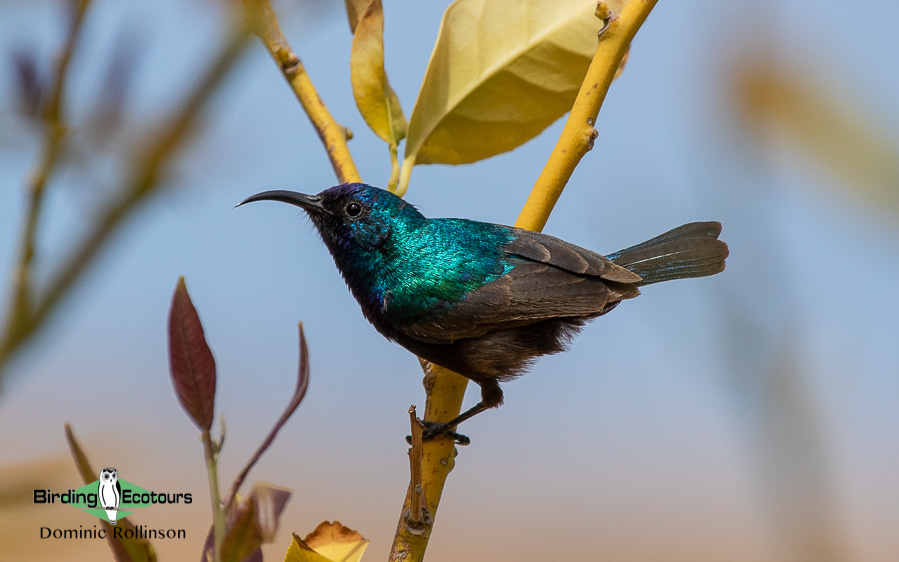
You can join our Socotra Birding Tour: Endemic Birds and Dragon Blood Trees which has been designed to run before and complement this Oman birdwatching tour. On Socotra you will be immersed in an otherworldly landscape filled with unique plants and wildlife, including nine single-island endemics, such as Socotra Golden-winged Grosbeak, while witnessing some truly breathtaking scenery.
Detailed Itinerary (12 days/ 11 nights)
Day 1. Arrival in Muscat
This is a non-birding arrival day, with your afternoon arrival at Muscat International Airport ahead of our early start to the Oman birding tour the following morning. We will gather at our comfortable hotel near the airport for an evening welcome dinner.
Overnight: Novotel Muscat, Muscat
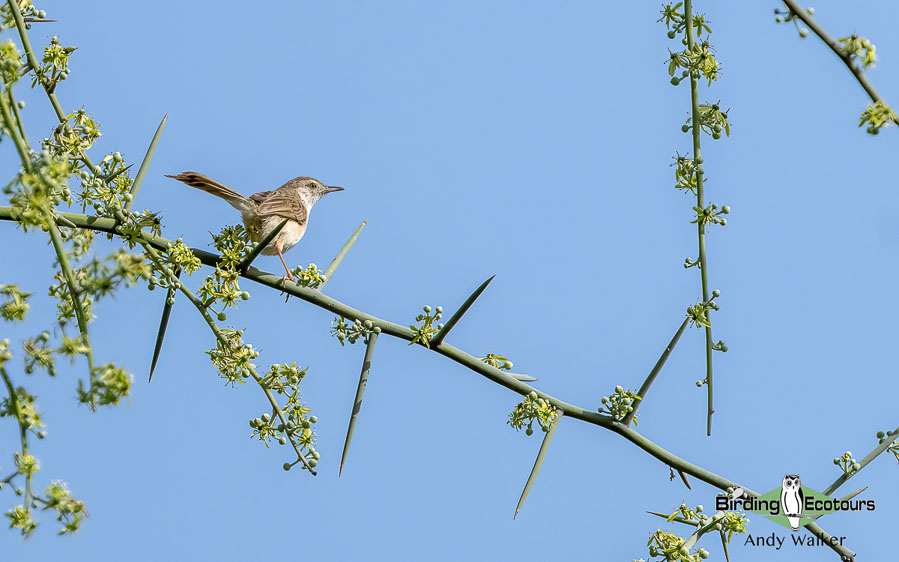
Day 2. Muscat birding
Oman’s bustling capital, Muscat, is located in the north along the Arabian Sea coast. It is an ideal starting point for our tour, with productive wetlands on the city’s outskirts and easy access to the Al Hajar and Jebel Akhdar Mountains. We will be based here with some early morning birding within Muscat itself, hoping to see Egyptian Nightjar soon after dawn. We will visit sites such as Al Ansab Lagoons, and Wadi Adai Preserve, where we will look for Garganey, Ferruginous Duck, Greater Flamingo, Pallid Swift, Black-winged Stilt, White-tailed and Red-wattled Lapwings, Tibetan and Greater Sand Plovers, Kentish Plover, Marsh and Wood Sandpipers, Temminck’s and Little Stints, Slender-billed and Sooty Gulls, Whiskered, Lesser Crested, and Greater Crested Terns, Western Reef, Striated and Squacco Herons, Greater Spotted Eagle, Arabian Green Bee-eater, Indian Roller, Delicate Prinia, Clamorous Reed Warbler, Purple Sunbird, and Citrine and Western Yellow Wagtails among many others. Our expert local guides will be aware of any rarer species reported near Muscat, such as Sooty Falcon or Crab-plover, and if either are present, we will make a special effort to see them.
During the afternoon, we will visit arable land around Al Barka, to the north of Muscat, in search of our first open country specials, such as Cream-colored Courser, Namaqua Dove, Black-winged Kite, Tawny Pipit, Desert, Isabelline, and Red-tailed Wheatears, and Striolated Bunting, with another opportunity to see Egyptian Nightjar. Afterwards, we will transfer to our remote guesthouse, nestled in the picturesque village of Hadash, offering breathtaking views of the Al Hajar mountains and surrounding hillside. After some time to relax and enjoy delicious Omani cuisine, there will be a chance for night birding as we begin our quest to find the enigmatic Omani Owl, alongside Pallid Scops Owl, and Arabian Eagle-Owl.
Overnight: Hadash Guest House, Ghubrah
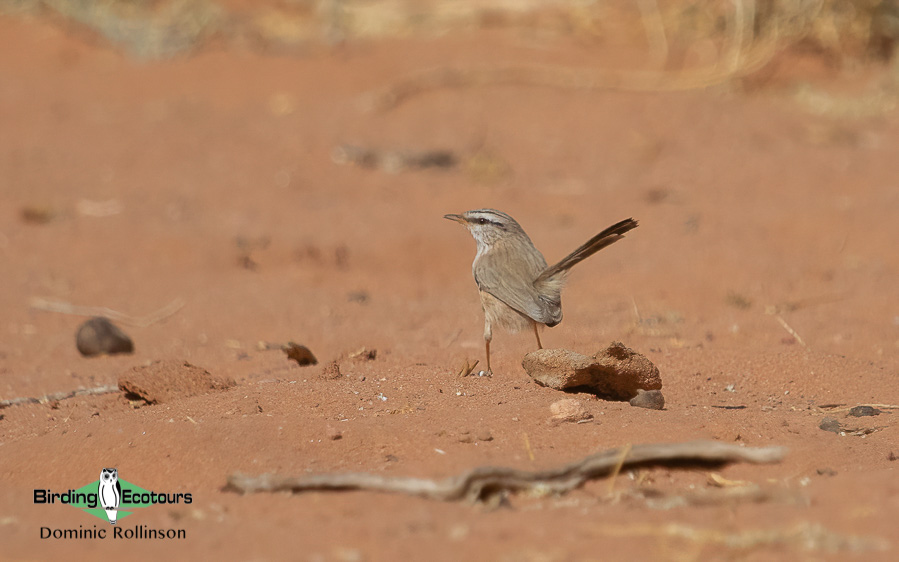
Day 3. Birding around Nakhl
Continuing our exploration of northern Oman, we will travel the short distance to the Nakhl area, renowned for its historic forts, impressive waterfalls, and spring blooms of apricot and pomegranate blossoms. Here, under the backdrop of the Al Hajar Mountains, we will explore wadis, oases, and date palm groves in search of Arabian Peninsula endemics, such as Arabian Green Bee-eater, White-spectacled Bulbul, and Arabian Babbler, along with Little Owl, Delicate Prinia, Streaked Scrub Warbler, Pale Crag Martin, Hume’s Wheatear, Blackstart, Purple Sunbird, Indian Silverbill, Desert Lark, and the non-native Grey Francolin. The orchards, gardens, tamarisk thickets, and acacia savanna in this area provide ideal habitats for wintering Plain Leaf Warbler, Eversmann’s Redstart, and Menetries’s Warbler, which breed in Central Asia during the summer months. While sightings are rare, we will keep our eyes peeled for species like Black-throated Thrush, an irruptive vagrant from Russia, and Lichtenstein’s Sandgrouse, which we hope to see drinking at an oasis. Between birding, we can relax in the comfort of our charming guest house, and in the evening, we will have another opportunity to try for Omani Owl, Pallid Scops Owl, and Arabian Eagle-Owl.
Overnight: Hadash Guest House, Ghubrah
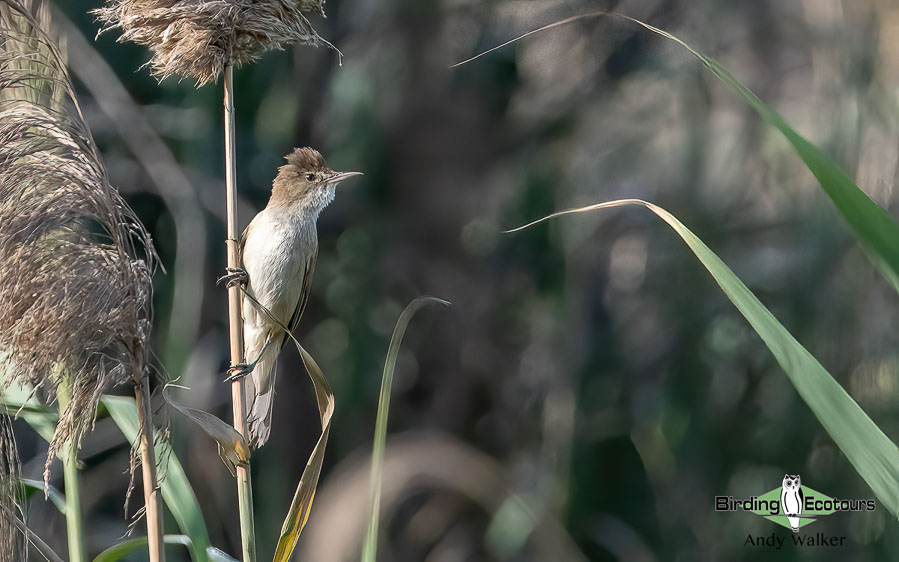
Day 4. Birding the Jebel Akhdar mountain range
Departing our accommodation early, we will travel southwest to the Jebel Akhdar mountain range, a protected nature reserve, and stunning area renowned for its network of wadis, terraced orchards, and magnificent views. While here, we will spend time at Jebel Shams, the highest mountain in Oman at 9,840 feet (3,000 meters), and visit the Al Nakhur Canyon – so impressive, it is often referred to as the Grand Canyon of Arabia. This area has a mild Mediterranean climate, and the higher altitudes receive more rainfall than much of northern Oman, creating a relatively lush, green landscape. One of our major targets here is the strikingly plumaged, yet elusive, Sand Partridge, but the raptors we could see are equally exciting, with Lappet-faced, Griffon, and Egyptian Vultures, and Bonelli’s Eagle all possible. We will search the open rocky areas, shrublands, juniper forests, and cultivated areas for songbirds such as the Arabian subspecies of Great Grey Shrike, Pale Crag Martin, Asian Desert Warbler, Eastern Orphean Warbler, Blue Rock Thrush, Desert Lark, and Hooded, Red-tailed, Hume’s and if we are lucky, Variable Wheatears. Our accommodation for the night is another beautiful guest house nestled amidst spectacular mountain vistas. This will be our final chance to look for Pallid Scops Owl and the rare and mysterious Omani Owl, which can be hard to see, but for which we will put all our effort into finding.
Overnight: Tilal Al Qatara, Mashūq
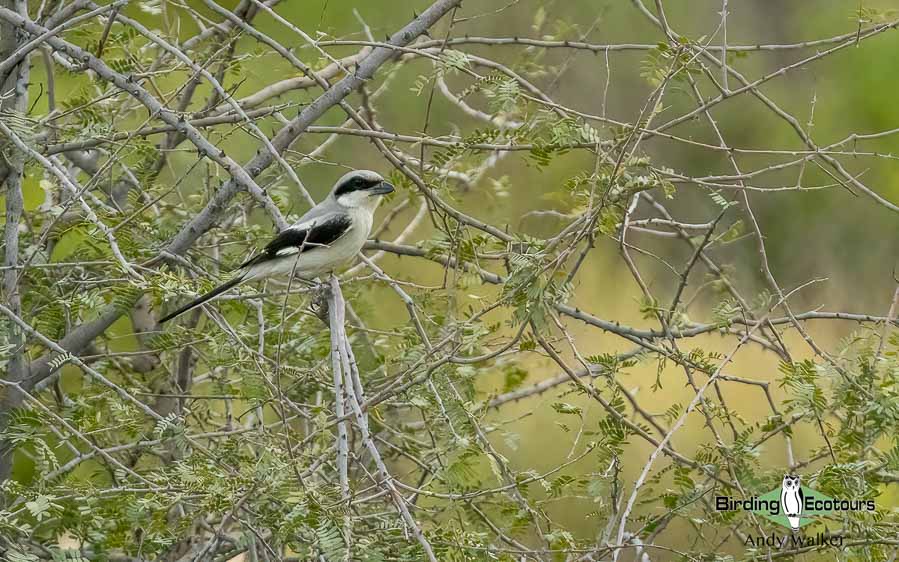
Day 5. Mountain birding and transfer to southern Oman
Being our final morning in northern Oman, we will be sure to take in the magnificent mountain views over a delicious breakfast before departing and slowly making our way back to Muscat. Since we will be starting the day in the heights of the Jebel Akhdar mountain range, we may continue with some high altitude birding to seek more of the species targeted the previous day. Sand Partridge, Lappet-faced Vulture, and Variable Wheatear are big tour targets and are most likely found here, so we may try again for these species, if needed. However, our schedule is flexible, and we may choose to leave the mountains earlier to spend more time in the diverse lowlands, depending on what species we still want to target, or if, for example, Crab-plover has been reported in the wetlands close to Muscat. In the late afternoon, we will board a domestic flight to Salalah in southern Oman as this is the quickest way to get to our next destination. On arrival in Salalah, and after a short transfer, we will check into our plush hotel, which will be our accommodation for the next three nights.
Overnight: Salalah Gardens Hotel, Salalah
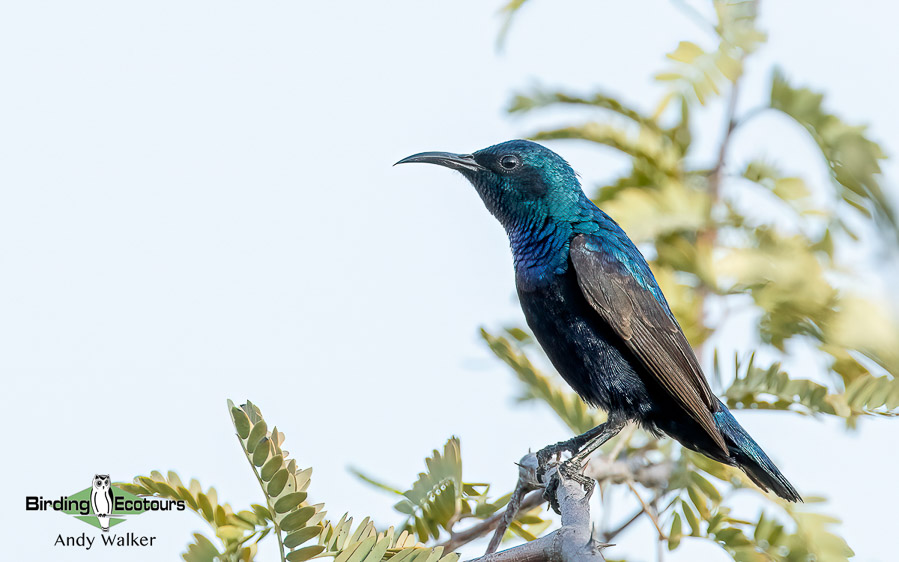
Day 6. Exploring Salalah
Located in southwest Oman between the Dhofar mountains and Arabian Sea, Salalah is milder than much of Oman, and experiences a monsoon climate, making the region lush and fertile. The area has a mesmerizing, unique feel, reminiscent of the tropical East African coast, yet it is only a short distance from the arid desert landscapes which cover much of Oman. Its location and climate combine to make it one of the most bird-diverse regions in the Arabian Peninsula, with a mix of fascinating Arabian, Asian, and African specials. We will use Salalah as our main base for the rest of the trip to explore this diverse and exciting region.
Today we plan to visit several wadis and wetlands on the outskirts of Salalah including the UNESCO world heritage site of Al-Baleed Archaeological park, and the beautiful Ayn Korr Nature Reserve, and we will likely return to the hotel to relax during the hottest part of the day. Throughout the day, we will target several species with restricted global ranges, such as Abyssinian White-eye, Tristram’s Starling, and Graceful Prinia, as well as more widespread African species such as Spotted Thick-knee, Spur-winged Lapwing, Diederik Cuckoo, and African Silverbill, here at the eastern limit of their range. Other major targets will include migratory waterbirds like Cotton Pygmy Goose, Yellow Bittern, Abdim’s Stork, Small Pratincole, and Pheasant-tailed Jacana, though we should also encounter more common species such as Greater Flamingo, Glossy Ibis, Purple Heron, Indian Pond Heron, Broad-billed, Curlew, Marsh, Green, and Wood Sandpipers, and Temminck’s and Little Stints. The raptors in this area are interesting too, and we will keep an eye out for Greater Spotted Eagle, Steppe Eagle, Crested Honey Buzzard, and Western Marsh Harrier. We will conclude our afternoon birding along the coast west of Salalah, staying until dusk to try for Desert Owl, which becomes active just after nightfall.
Overnight: Salalah Gardens Hotel, Salalah
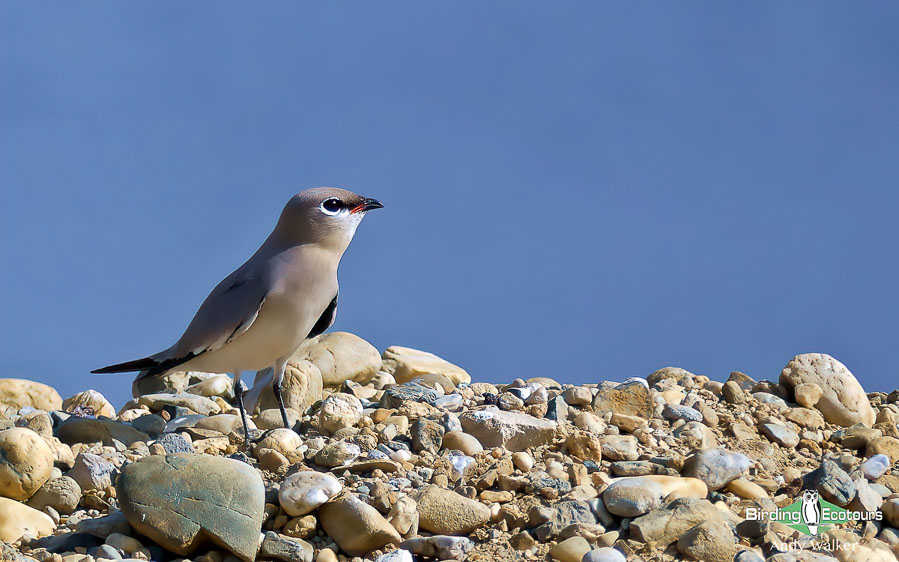
Day 7. Birding the slopes of the Dhofar mountains
We will continue to use Salalah as our base, as we will explore the wooded wadis, dry scrub, and rocky hillsides of the slopes of the Dhofar Mountains to the north and east of the city. We are likely to see a long list of species, but our most important targets in the foothills are three of Oman’s most sought-after species, found only here, in Yemen, or Saudi Arabia – Arabian Partridge, Arabian Sunbird, and Arabian Golden-winged Grosbeak. Additionally, Arabian Warbler, Rüppell’s Weaver, and Palestine Sunbird are also high on our list, being near endemics to the Arabian Peninsula and with a restricted distribution in Africa. Other species we will target include Steppe Eagle, Bruce’s Green Pigeon, Grey-headed Kingfisher, Blue-cheeked Bee-eater, Eurasian Hoopoe, Singing Bush Lark, Red-tailed and Isabelline Shrikes, Desert Wheatear, Blackstart, African Silverbill, Long-billed Pipit, and Cinnamon-breasted Bunting. After another delicious meal, we will go owling, searching for two Arabian endemics. Our main target is Arabian Scops Owl, which is much more common in southern Oman compared to northern Oman, and we have another chance for the impressive Arabian Eagle-Owl.
Overnight: Salalah Gardens Hotel, Salalah
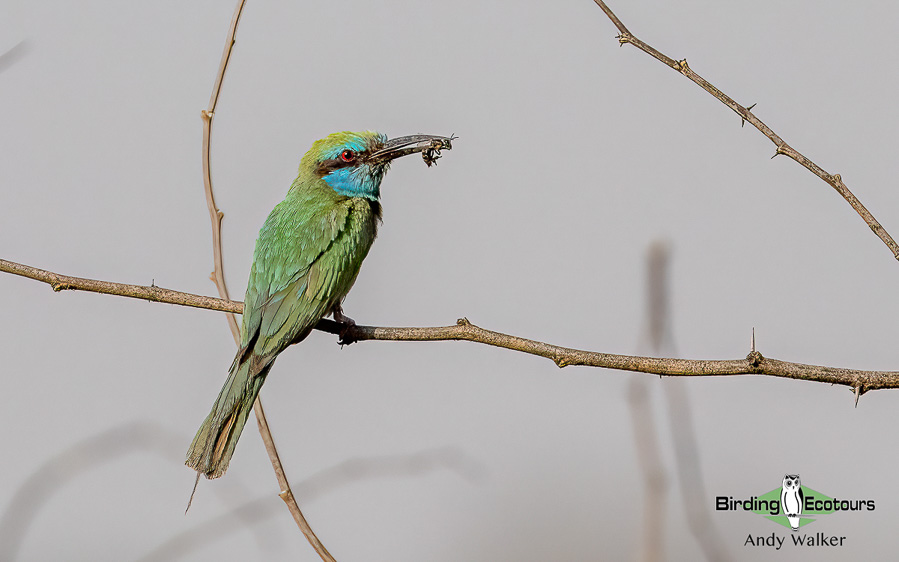
Day 8. Oman desert birding
This will be a much-anticipated day as we venture north from coastal Salalah, to the true desert interior of Oman around Mughshin. Our birding will be in stark contrast to the previous days spent exploring wadis and wooded hillsides, as we now immerse ourselves in the vast openness of shifting sand dunes. Although we have a long drive from Salalah (around three and a half hours) we will make frequent stops as the key birding sites are along the route.
Our big targets are a trio of sandgrouse, with Chestnut-bellied, Spotted, and Crowned Sandgrouse all regularly seen in this area. We will also look for the highly sought-after nomadic Grey Hypocolius, along with Arabian Lark, an endemic species to the Arabian Peninsula, Nile Valley Sunbird, Cream-colored Courser, and Egyptian Nightjar. This is an exciting place to birdwatch as a vast number of migratory species pass through or spend the winter here, including the rare IUCN Critically Endangered Sociable Lapwing as well as Black-throated Thrush, and Rufous-tailed Scrub Robin. While we would be fortunate to encounter any of these three species, we will certainly be looking out for them all. More commonly, we may see migratory Pallid Harrier, European Nightjar, Blue-cheeked Bee-eater, Eurasian Golden Oriole, Eurasian Hoopoe, Pied and Desert Wheatears, Bluethroat, Spotted and Red-breasted Flycatchers, Menetries’s Warbler, Asian Desert Warbler, Red-backed, Red-tailed, and Isabelline Shrikes, Rosy Starling, and Tawny, Tree, and Red-throated Pipits. Resident species here include Golden Eagle, Greater Hoopoe-Lark, Great Grey Shrike, and Black-crowned Sparrow-Lark and we will have our eyes peeled for these too. This is likely to be a long day as we will maximize our time in this special landscape, though we will ensure that there is opportunity to rest sufficiently and avoid the hottest part of the day, as far as is possible.
Overnight: Qatbit Hotel, Mughshin (please see the “Accommodation Note” below).
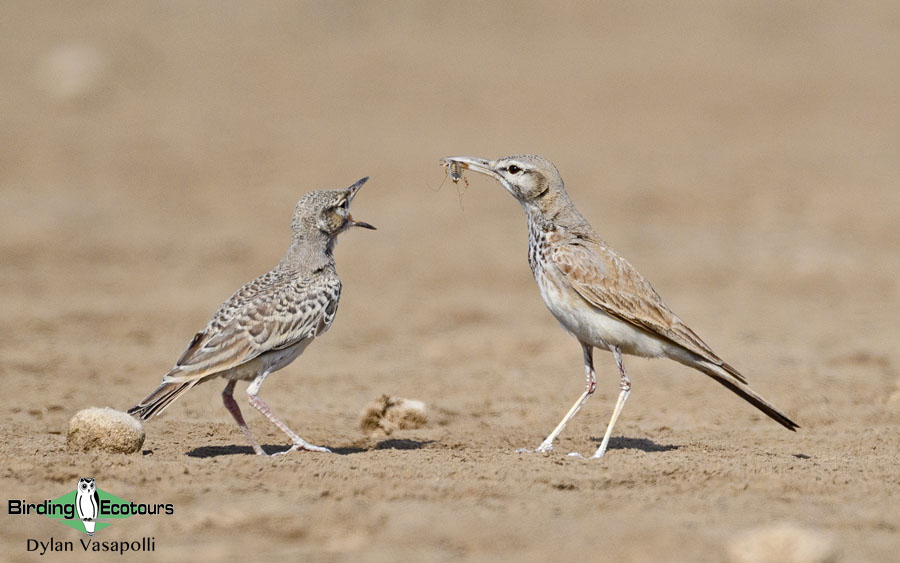
Day 9. Desert birding and return to Salalah
We will begin with some early morning birding in the hotel gardens, which serve as a major migrant trap and have previously turned up some interesting vagrants, such as Hume’s Leaf and Upcher’s Warblers. Afterwards, we will continue targeting species mentioned for Day 8 by exploring the desert around Mughshin, before starting our journey back to Salalah, stopping at various agricultural areas along the way. Given the nomadic nature of desert species, we may not see all our targets listed for Day 8, but we will certainly spend time seeking them during the time we have for desert birding, especially for exciting species such as Grey Hypocolius, Sociable Lapwing, and Arabian Lark. We will aim to arrive at our comfortable resort hotel in the late afternoon, allowing time to relax before the evening meal.
Overnight: Salalah Gardens Hotel, Salalah
Day 10. Khor Rori and the Sumhuram Archaeological site
Departing Salalah, we will travel east to explore some lush wadis, with our main destination being the large Wadi Darbat. Here, we have another chance for Arabian Partridge, Arabian and Palestine Sunbirds, and Arabian Golden-winged Grosbeak, along with several African species including Bruce’s Green Pigeon, Diederik Cuckoo, Grey-headed Kingfisher, Black-crowned Tchagra, African Paradise Flycatcher, and Rüppell’s Weaver. Furthermore, Arabian Scops Owl and Arabian Eagle-Owl are sometimes seen at day roosts here, so we will watch for what would be a special sighting of these owls.
Following a picnic by the wadi, we will explore Khor Rori area and the ruins of the Sumhuram Archaeological site, which border Wadi Darbat. This area is ideal for open ground species, such as Bonelli’s Eagle, Eurasian Hoopoe, Isabelline Wheatear, Siberian Stonechat, Blackstart, and Striolated Bunting. The extensive beach and tidal lagoon, where the wadi meets the Arabian Sea, can be productive for wading species and other interesting waterbirds, species such as Red-knobbed Coot, Pheasant-tailed Jacana, White-winged Tern, and Eurasian Spoonbill. We will finish our day by visiting a site for another Arabian endemic, Yemen Serin, and then visit a wooded wadi to see a magnificent stand of African baobab trees, which are very rare outside of Africa. Depending on our previous success over recent days, we may go night birding for Arabian Scops Owl and Arabian Eagle-Owl. We will overnight in the coastal town of Mirbat, east of Salalah, to position ourselves well for the boat trip the following morning.
Overnight: Wyndham Garden, Mirbat
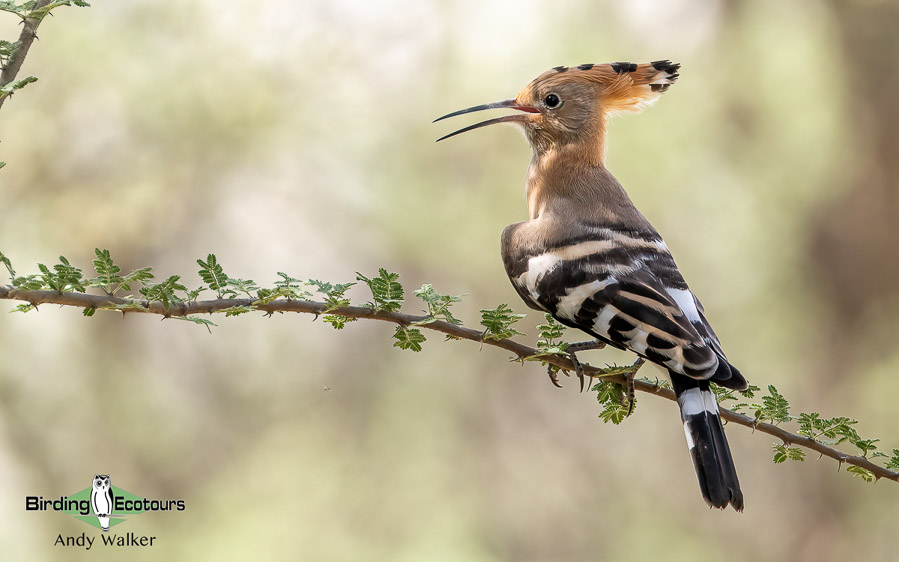
Day 11. Mirbat pelagic and Djebel Samhan Nature Reserve
For some, this may well be the tour highlight. Early in the morning, we board a boat from Mirbat harbor, an activity renowned among international birders due to the number of rare seabird species possible on this pelagic trip. Our main targets will include species restricted to the Red Sea and northern Indian Ocean, such as Socotra Cormorant, Saunders’s and White-cheeked Terns, Sooty Gull, Persian Shearwater, and Jouanin’s Petrel. The sheer numbers of seabirds are a delight, and it is not uncommon to encounter large flocks of Red-necked Phalarope too. Other species we hope to see include Bridled Tern, Caspian Gull, Wilson’s and Swinhoe’s Storm Petrels, Red-billed Tropicbird, Flesh-footed Shearwater, Masked and Brown Boobies, among many others, and marine mammals, such as Sperm Whale, Spinner Dolphin, and Indian Ocean Humpback Dolphin.
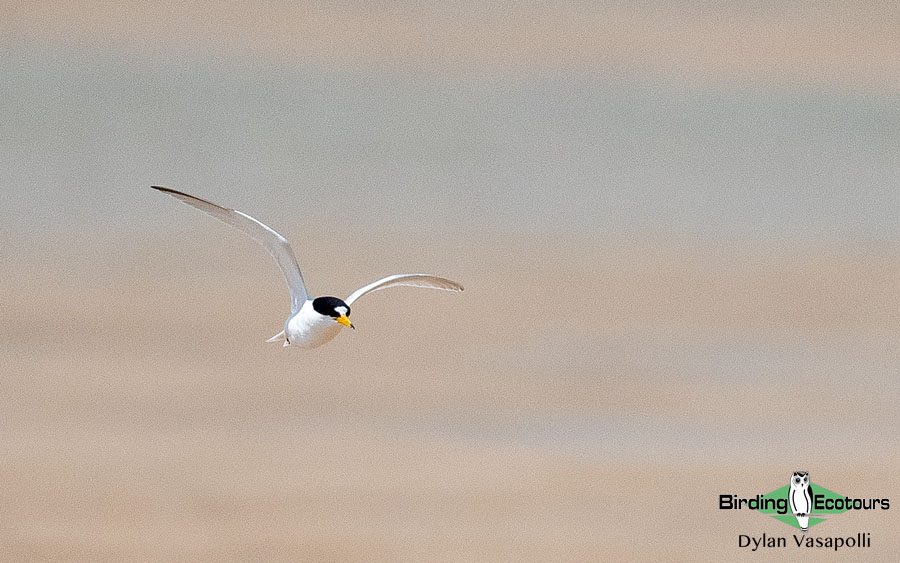
After a great lunch back on dry land, we will explore the mountain steppes of Djebel Samhan Nature Reserve, an area protecting vast expanses of the Dhofar mountains. This reserve is one of the last strongholds of the IUCN Critically Endangered Arabian Leopard, an endemic subspecies with fewer than 150 individuals left in the wild. While spotting one would be incredibly rare, the breathtaking views of the mountainous terrain offer plenty of other rewards. Our main avian target here is Arabian Wheatear, another species restricted to the Arabian Peninsula, which is seen regularly in the rocky hillsides in the nature reserve. Other targets include Arabian Partridge, Fan-tailed Raven, and a variety of eagles, with Verreaux’s, Eastern Imperial, Short-toed Snake, Steppe, Booted, and Greater Spotted Eagles all possible, plus Rock Hyrax. On our way back to our relaxing hotel, we visit a stretch of dramatic coastal cliffs, where we hope to see the rarely seen Forbes-Watson’s Swift, a species with a unique distribution, isolated to coastal habitats in southern Arabia, Socotra, and East Africa. Migratory Pallid Swift are much more common this time of year, so we will carefully scan flocks to identify the rarer Forbes-Watson’s Swift.
Overnight: Wyndham Garden, Mirbat
Day 12. Tour concludes, departure from Salalah
Our birding this morning will be flexible, dependent on the success of the previous few days. We may choose to revisit one of the areas near Salalah for better views of Arabian Golden-winged Grosbeak or Yemen Serin, for example, or make another attempt at finding the rare Sociable Lapwing. Alternatively, we might decide to explore new areas to the west of Salalah, where coastal birding could offer a chance to encounter rare migrants such as African Sacred Ibis.
After lunch, the tour will conclude at Salalah International Airport. However, those interested in a short two-day stopover in the UAE to try for Crab-plover, Pharaoh Eagle-Owl, Sociable Lapwing and Variable Wheatear, will continue to Dubai.
Overnight: Not included
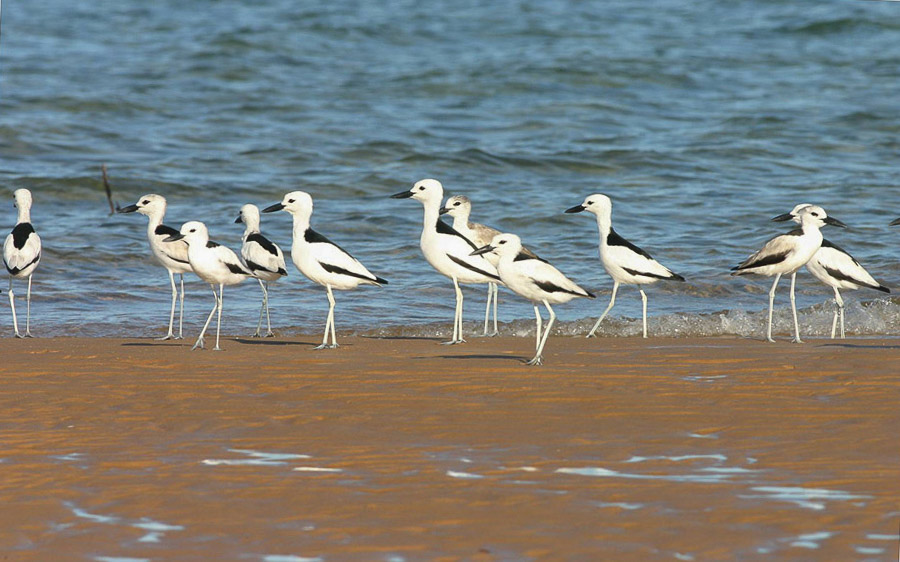
Please note that the itinerary cannot be guaranteed as it is only a rough guide and can be changed (usually only slightly) due to factors such as availability of accommodation, updated information on the state of accommodation, roads, or birding sites, the discretion of the guides and other factors. In addition, we sometimes have to use a different guide from the one advertised due to tour scheduling and other factors.
Download ItineraryOMAN BIRDING TOUR: ENDEMIC BIRDS OF THE ARABIAN PENINSULA
OMAN: GENERAL INFORMATION
TOUR OUTLINE
On this Oman birding tour, we explore the best birding sites of the Sultanate of Oman, one of the safest and most biodiverse countries in the Arabian Peninsula. The tour targets Arabian endemics, desert specialties, wintering migrants from Europe and Asia, and African species at the eastern edge of their range. We also include a full-day pelagic trip from the southern coast to search for rare seabirds. Accommodation is comfortable and well-placed throughout, giving us good access to the best birding sites in both northern and southern Oman.
We begin the tour in northern Oman, birding the coast, grassland and wetlands around Muscat for amazing species like Sooty Falcon and Cream-colored Courser, before moving into the Al Hajar Mountains in search of key targets such as Omani Owl, Arabian Eagle-Owl, Arabian Green Bee-eater, and Arabian Babbler. From the slopes of Jebel Akhdar, we look for Sand Partridge, Lappet-faced Vulture, and a variety of wheatears, warblers, and other highland specialists. We then fly south to coastal Salalah, where we base ourselves for several days to explore the surrounding wadis, coastal wetlands, and mountain steppe. Key targets here include Arabian Warbler, Arabian Sunbird, and Arabian Golden-winged Grosbeak, alongside wintering migrants, while night birding offers chances for Desert Owl and Arabian Scops Owl.
We then head into Oman’s interior deserts around Mughshin, where we search for desert species including Grey Hypocolius, Arabian Lark, and three species of sandgrouse. The desert is a brilliant place to search for migrants, and we will look for raptors, shrikes, warblers, wheatears, pipits and many others, among star birds such as the Critically Endangered (BirdLife International) Sociable Lapwing. We finish the tour near Mirbat, with a dedicated pelagic trip targeting Socotra Cormorant, Jouanin’s Petrel, Persian Shearwater, and other seabirds of the Arabian Sea. Inland, we explore the Djebel Samhan Nature Reserve for Arabian Partridge, Arabian Wheatear, raptors, and make a final attempt to find the range-restricted Forbes-Watson’s Swift.
DAILY ACTIVITIES, PHYSICAL REQUIREMENTS, AND TOUR PACE
Our Oman birding tour varies in pace. The northern section (Days 1 to 4) can be fast-paced at times, with two single-night stays and considerable travel on Days 2 to 4. This itinerary is designed to maximize birding opportunities, particularly for key species like the elusive Omani Owl, which, to reach the right sites for, may involve drives of up to an hour and possibly multiple attempts over different nights. During the day we will start early to try to find brilliant species such as Sand Partridge, and Lichtenstein’s Sandgrouse. These early starts and late finishes are balanced by a midday rest period during the hottest part of the day when bird activity is minimal. All night birding is entirely optional, and anyone who prefers not to join may rest at the hotel.
From Day 6 onwards, when the tour is in southern Oman, the pace slows, with fewer hotel changes and less night birding. Based in Salalah and Mirbat, we explore the surrounding landscapes from comfortable hotels. That said, at night in the south, we will be targeting the beautiful Desert Owl among others, and starting early to target Arabian endemics like Arabian Sunbird and Arabian Golden-winged Grosbeak, but the structure is more relaxed. Additionally, across two of our days based in the south, we will venture into Oman’s interior to seek out its specialist desert species. During this time we will maximize birding to make the most of being in this special environment, and ensure periods of rest back in Salalah after this excursion.
Our days typically begin at around 05:30 to 06:00 hrs., with either a boxed breakfast taken into the field, or we may opt to go straight out birding and then return to the hotel for breakfast a few hours later. Bird activity usually drops off during the heat of the middle of the day, when we will take a break for lunch and a chance to rest and refresh, followed by late afternoon birding before our group evening dinner and then night birding. Birding is a mix of roadside stops and short walks along trails or quiet roads through open desert, mountain steppe, wadis, wetlands, gardens, and orchards. The birding in Oman is typically in open habitats so there are often excellent opportunities for photography during the tour.
The tour is generally considered easy to moderate in terms of physical effort, mainly relating to the heat. While we visit during the cooler winter season, daytime temperatures can still reach 90°F (32°C, see the “Weather/Climate” section below for more details). Some birding days will be physically easy and largely vehicle-based, but on several occasions we may walk around 2.5 miles (4.0 kilometres) along quiet roads or mountain trails, with frequent birding stops made. There is little uphill walking, but walking sticks or hiking poles may be helpful for those who prefer extra stability and are essential for anyone who feels unsteady on their feet, as your safety is our top priority.
This tour involves some long drives, and on some days we will spend most of the day out birding, using our vehicle as a base. On these days, we will either have lunch at a restaurant, café or at the vehicle, rather than returning to our accommodation, and we will give you plenty of notice in advance. During the tour, we take a domestic flight (between Muscat and Salalah) and two boat trips (one a morning-long pelagic to search for rare seabirds of the region, the other a short hour-long boat trip to try to see Sooty Falcon). See the “Tour Flight” and “Oman Pelagic Birdwatching and Sooty Falcon Trip” sections below for more details.
SPECIES RECORDING (BIRD LISTS AND ANIMAL LISTS)
Ahead of the tour we will email you a detailed daily itinerary complete with meeting/arrival instructions. We will provide you with a printed blank diary page within the itinerary document so that you can note down any names of birding sites that you may want to log. On the first night of the tour you will be provided with a printed version of the same itinerary. Each evening your tour leader will go through this with you to let you know any specifics to be aware of for the following day (e.g. clothes and equipment needed, breakfast time, time for leaving the hotel, key target birds we will be looking for, etc.).
Attached to the itinerary document will be a bird list and list of other animals possible on the tour (or a blank list to write them in as we go). We follow the latest IOC (International Ornithological Congress taxonomy) for birds and International Union for Conservation of Nature (IUCN) for all other animals recorded during the tour so all itineraries and checklists follow these taxonomies.
Each evening we will go through the daily bird and animal lists, logging all the species from the day. The listing session is optional, we realize that some of our clients aren’t fussed about the listing aspect, but others are. If you do not want to take part in the nightly bird list that is perfectly fine, but it is a useful way to remember what was seen during the day, so recommended.
Birding Ecotours leaders maintain eBird checklists from all birding activities during a tour (from unexpected roadside stops to planned birding activities). Tour leaders will share these eBird lists with all participants who use eBird, if desired. Just make sure to provide your eBird user details to the tour leader at the beginning of the tour for us to be able to do this, unfortunately we can’t retrospectively go back and share past checklists after the tour. We will also provide you with an eBird trip report for the tour where we will add our photos taken on the tour and you are welcome to include your own too.
After the tour you will be emailed a PDF copy of a written trip report, this will be in the form of an illustrated daily diary and will include a complete checklist of all wildlife recorded. If the tour leader manages to get any interesting photographs these will be included in the trip report. Leader photos may also be added to our Flickr page and will be added into a “trip report gallery” which you can view, download, and share.
PASSPORT, VISA, AND ENTRY REQUIREMENTS
Most visitors to Oman do not require a visa for stays of up to 14 days under the country’s new visa-free tourist policy. However, as entry and exit rules can change at short notice, it is essential to check the latest information on the Oman immigration website before travel. Do not assume you will be eligible for visa-free entry without checking. Citizens of the United States (US), Canada, the United Kingdom (UK), and Australia are currently eligible for this 14-day visa-free entry. Please confirm details via your own government’s advice, see here for the US, here for Canada, here for the UK, and here for Australia. Citizens of other countries not listed above should check their own government’s advice and contact their nearest embassies/consulates for up-to-date regulations and requirements. For example, while proof of vaccinations are not needed to enter Oman, if you are traveling from a country listed as a Yellow Fever transmission risk you will need to show proof of vaccination.
Visa-free entry is granted provided you have:
-
A passport valid for at least six months beyond your arrival
-
At least one blank passport page for entry/exit stamps
-
Confirmed hotel bookings for the duration of your stay and a return or onward flight ticket
-
Valid travel health insurance
-
Proof of sufficient funds
This 14-day entry cannot be extended. If you overstay or fail to obtain the correct visa, you may be fined and risk detention. For stays longer than 14 days you must obtain a visa. You can apply online via the Royal Oman Police e-visa system (select the “unsponsored visit visa” for tourism), or obtain a visa on arrival at the airport.
Please make sure that you bring a photocopy of your passport with you on the tour, to be kept in a different location to your original passport, in case of loss/damage. This can be kept with other important documents such as vaccine certificates, emergency contact details, and insurance documents. Digital copies of these saved on a “cloud” system can also be useful.
Oman enforces strict customs regulations. Please review the relevant customs guidance before travel. As an example, non-Muslims over the age of 21 may bring up to two liters or 24 cans of alcoholic beverages, and up to 100 ml of perfume.
TRAVEL INSURANCE
As per our standard Terms and Conditions, we strongly recommend that you purchase comprehensive trip cancellation insurance to protect against unexpected events that might cause delays and interruptions to travel. Your insurance should also cover illness, medical issues, accidents, repatriation, loss of luggage or valuable items, flight delays/cancellations, and ideally medical evacuation included. Failure to purchase adequate insurance could be costly if something unexpected occurs.
HEALTH, VACCINATIONS, AND MEDICAL CONDITIONS
We recommend you are up to date with routine vaccinations for visiting Oman, including measles-mumps-rubella (MMR), tetanus, diphtheria, polio, chickenpox, flu, shingles, and COVID-19. In addition, Hepatitis A is strongly recommended for all travelers, and Hepatitis B is also advised. As we will be visiting rural areas, a Typhoid vaccine would be beneficial too. While malaria is not present in Oman, insect-borne illnesses such as dengue, leishmaniasis, and tick-borne infections do occur, albeit rarely. To reduce risk, use mosquito repellent and wear long pants and long-sleeved shirts, particularly at night. There is also a low risk of water-borne illnesses, such as Leptospirosis, so we recommend avoiding swimming in freshwater areas in rural regions. Please carefully read the CDC traveler advice which contains information on required vaccinations to enter Oman. Please note, Oman requires a valid Yellow Fever Certificate if you are traveling from a region where yellow fever is present.
As per our general Terms and Conditions, we require you to notify us at the time of registering for this tour of any medical conditions that we should know about (these should include, but not be limited to, walking/mobility issues, allergies, heart conditions, diabetes, epilepsy, long-term illnesses etc.). While in Oman we will not be far from major hospitals, located in the capital Muscat, and Salalah. During our excursion into the desert in the south, the mountains in the north, and while on our pelagic trip, we will be further from hospitals and medical facilities. Please make sure that you are covered with suitable medical insurance in case of an emergency while on the tour, because without insurance the cost for medical care is likely to be extremely high. In addition, many hospitals/medical clinics will require payment upfront for treatment and these costs could be much higher than what you might expect at home.
SAFETY, DANGEROUS ANIMALS, AND LOCAL CUSTOMS
Oman is widely regarded as one of the safest countries in the Middle East, with very low crime rates and a welcoming atmosphere for visitors. Crime rates are lower than in Australia, or the United Kingdom for example, but rarely, tourists can be targeted in the larger urban areas so please keep a close watch over your possessions (e.g., bags, wallet, optics, etc.). Although the risk is low, terrorism remains a global concern, especially considering Oman borders Yemen in the south. Your guides will monitor local news and official advice both before and during the tour.
While we would consider ourselves lucky to encounter one, Oman has several species of venomous snakes and scorpions. Species such as the Omani Carpet Viper, Arabian Cobra, Arabian Horned Viper, and Puff Adder, inhabit rocky, mountainous areas, while scorpions such as the Arabian Fat-tailed Scorpion, are more common in deserts and wadis. Few of these pose a serious threat to life, and antivenom is widely available at health centers. Nevertheless, we highly recommend taking basic precautions such as wearing sturdy footwear, using a torch at night, and being cautious where you are stepping when walking outdoors.
Oman is a conservative Islamic country with strong cultural traditions and social norms. While the Omani people are known for their warmth and hospitality, it is important that visitors respect local customs and laws. Modest dress is expected in public and both men and women should cover shoulders and knees, and swimwear should only be worn at hotel pools or private beaches. Women may wish to carry a scarf to cover their hair if planning to enter mosques or more conservative areas before or after the tour (our itinerary does not include any locations where this would be required). Alcohol is available at licensed hotels, restaurants, and bars, but drinking in public is illegal and may lead to arrest. Visitors must not bring alcohol into the country beyond the limits allowed by customs regulations. Photographing government buildings, military sites, oil or gas related buildings, or local people (especially women and children) without permission is also illegal. Omani laws are strictly enforced, and penalties for breaking them can be severe.
FOOD AND WATER
Filtered water is generally available at our accommodations. While out birding and visiting more remote areas, it is best to only drink bottled water. An ample supply of drinking water is available throughout the tour in our vehicle, so please bring a refillable water bottle to try and reduce the amount of plastic waste generated during the tour. Ice is considered safe in high standard restaurants and hotels but should probably be avoided in rural areas or on street stalls.
Mealtimes are likely to be within normal eating hours, but these will be somewhat flexible depending on our birding/travel plans and so if you need to eat food at a specific time of day (e.g. to agree with medication you are on) you may need to bring snacks to supplement the above, such as cereal bars, protein bars, and dried fruit etc. We will not make regular stops at convenience stores, but there will be occasional opportunities to purchase items when time allows.
Dietary preferences are well catered for at the hotels we use and in restaurants in Muscat, Salalah, and larger towns. Omani cuisine features a blend of traditional Middle Eastern and Arabian dishes, including plenty of chicken, fresh seafood, rice, flatbread, and fragrant spices. Vegetarian choices and Western-style food is often available at the hotels, offering familiar options alongside local specialties, making the meals suitable for most palates. We typically have breakfast and dinner at our accommodation, with lunch taken at a café or restaurant after morning birding. On some occasions, we may provide packed breakfasts for convenience during early starts.
CURRENCY
The official currency of Oman is the Omani Rial (OMR). Banknotes are available in various denominations, and the local currency is used for almost all transactions. While we will be staying in hotels where cards are widely accepted, paying in local currency usually offers better value. We recommend carrying some local cash for smaller purchases, particularly when away from major towns, to avoid poor exchange rates and/or card surcharges. Visa and Mastercard are widely accepted at hotels and in major towns and cities and can be used to withdraw cash from ATMs (bank charges may apply), while use of American Express is more limited.
It will be possible to exchange or withdraw money on arrival into Oman at Muscat International Airport, but it might be easier to bring cash with you from home. A small amount of local cash will be useful for personal purchases not included in the tour costs and for any gratuities. See the full list of what is and is not included in the itinerary document. Always remain vigilant when using ATMs for your safety and security.
WEATHER/CLIMATE
Oman lies in the southeastern corner of the Arabian Peninsula, bordered by the Arabian Sea, the Gulf of Oman, and the Rub’ al Khali desert. Its position at the intersection of tropical and subtropical zones, combined with a varied topography results in a dry, arid climate with regional variation. The country experiences distinct seasonal shifts, with extremely hot summers from May to September and milder, more comfortable conditions from October to April. We visit Oman in November, one of the most pleasant months of the year, when daytime temperatures are hot but not extreme, typically ranging from 81 to 90°F (27 to 32°C), while nights are cooler and often refreshing, dropping to around 64 to 72°F (18 to 22°C). Rainfall is generally minimal in November, humidity is low, and the skies are usually clear, providing excellent conditions for birding and travel.
During this birdwatching tour, we begin in northern Oman, where the climate is dry and arid, with high daytime temperatures and cooler nights, especially in the mountains around Jebel Akhdar. When we fly to coastal Salalah, we encounter a more tropical and humid climate, with greener landscapes and milder temperatures influenced by the nearby sea and the effects of the summer monsoon. From Salalah, we make a short excursion into the desert interior, where conditions are especially hot and dry. To make the most of the cooler morning hours and peak bird activity, we will start early each day and adjust our schedule as needed based on temperature and weather conditions.
ELECTRICITY AND COMMUNICATION
The power plug sockets in Oman are of Type G, which are also used in United Kingdom, Ireland, Malaysia, Singapore, Hong Kong, and other countries in the Middle East such as Saudi Arabia. This socket only works with plug G. The standard voltage is 240 volts (V), and the standard frequency is 50 hertz (Hz). Further details (and photos) can be found here.
Adaptors are likely to be needed for some visitors from overseas; you may also need a voltage converter and should be careful with certain appliances that utilize different frequencies. You can use your electric devices in Oman if the standard voltage in your country is between 220 – 240 V (as is in the UK, Europe, and most of Asia and Africa). These small deviations are considered by manufacturers. If the standard voltage in your country is in the range of 100 – 127 V (as it is in the US, Canada, and most South American countries), you will need a voltage converter. You could also consider a combined power plug adapter/voltage converter to save space.
All hotels we use have Wi-Fi, aside from the one night in the desert near Mughshin. Given the general remote areas we will be in, it is possible that the Wi-Fi may sometimes drop so expect the connection to perhaps be unstable. Phone coverage is typically good near urban areas but will be patchy when we are in the mountains and desert.
TOUR FLIGHT
This tour requires a single domestic flight between Muscat and Salalah, the cost of which is included in the tour price. Once the tour is confirmed, we will purchase flight tickets for everyone in the group at the same time to ensure we are all on the same flight. This flight is typically operated by Oman Air, who are often strict on baggage weight allowances. If your bags are overweight at check-in, this may cause delays and added stress for you, your tour leader, and the rest of the group, so please ensure you stick to the allowances. We will confirm the exact baggage allowance once we book the domestic tickets. You should expect a baggage allowance of 44 lbs (20 kg) for checked baggage and 15 lbs (7 kg) for hand luggage – see here for more details, and let us know if you are interested in flying business class.
TRANSPORTATION AND LUGGAGE
We will use 4×4 SUV- or Land Cruiser-type vehicles throughout the tour. These are essential for crossing Oman’s desert and mountainous landscapes and for reaching the remote areas we will be visiting. The group will be split between two vehicles travelling in convoy, one driven by the local guide and the other by your Birding Ecotours guide. For larger groups we will hire an additional vehicle and driver to accompany the tour. We will use two different sets of 4x4s, one during the first five days in northern Oman and the other during the seven days in southern Oman. When transferring between hotels, you will travel with your luggage in the back of the SUV. We will use large vehicles and limit capacity to four persons per vehicle. However, please pack as lightly as possible for this tour, bearing in mind that you will be travelling with all your luggage on transfer days and that there is a weight limit on the domestic flight, as outlined above. A medium-sized, soft-sided and robust duffle bag is likely to be the best option for both the tour vehicles and the flight. You will be expected to load and unload your own bags as we move between locations during the tour.
OMAN PELAGIC BIRDWATCHING AND SOOTY FALCON TRIPS
This Oman birding tour includes an exciting pelagic trip out of Mirbat harbor, famous for the high abundance of seabird species which are restricted to the Arabian Sea and Indian Ocean. We will be out on the water for approximately four hours while we search for petrels and shearwaters, including the rarely seen Jouanin’s Petrel. We will board after breakfast and travel up to 15 nautical miles (28 kilometers) offshore into the Arabian Sea, returning to land around midday. This journey can be rough and occasionally uncomfortable, but hopefully worthwhile! Drinks are provided on board, though we recommend bringing anything specific you might want.
In addition to the Mirbat pelagic, we take a short boat trip to Al Fahal Island on the first full day of the tour. This is a well-known nesting site for the beautiful Sooty Falcon. These birds begin migrating to Madagascar in early October, but we hope to find a few that are yet to depart. We expect to be on the water for around one hour.
Whether the pelagic or boat trip goes ahead depends entirely on weather and sea conditions. At times, strong winds and dangerous swells may make it unsafe to go to sea. This decision will be made by our highly experienced skippers, and we rely on their final approval. Your safety is our top priority, and if conditions are not suitable, the vessel will not depart. Should our pelagic trip be cancelled entirely, we will likely spend more time exploring the mountain steppes of the impressive Djebel Samhan Nature Reserve.
If you are prone to seasickness (or uncertain of how you might react on a day on the sea) we recommend you bring some medication and take as directed. Staying hydrated on the boat is beneficial. If you do not think you will want to take part in the pelagic trip you will be able to remain at our accommodation and do some personal birding/relaxing etc.
Please also refer to the “What to take on the boat trips” section below.
ACCOMMODATION
We use good-quality hotels throughout our time in Oman. These are comfortable, modern, and well accustomed to international tourists, and importantly, they are well located for access to birding areas. For example, in northern Oman, we choose accommodation that gives us the best chance of seeing the elusive Omani Owl. All accommodations have private en-suite bathrooms with hot water, 24-hour electricity, Wi-Fi, and air conditioning. Laundry services are available throughout.
The only deviation from the above is for one night in the desert near Mughshin, where we are limited to basic accommodation as it is the only option available. While more basic than other hotels we use, this hotel has air conditioning and private bathrooms. Staying here allows us to access the desert at the best times before the heat sets in, and we will have comfortable accommodation in Salalah both before and after this night.
Sometimes we may need to use alternative accommodation to our preferred choices for a range of reasons that are out of our control, but we will provide a full list of accommodation details ahead of the tour commencing. We use “standard” rooms, as is typical for most group birding tours globally, and these are deemed sufficient for most participants. If you would like to upgrade to a higher standard of room, such as a “luxury” option, this may be possible in some locations depending on availability. Please note there will be an extra charge for room upgrades, and please contact us as early as possible to discuss options.
WHAT TO BRING:
Clothing
In Oman, the weather is expected to be hot during the day, so lightweight, breathable clothing is recommended. Quick-drying birding clothes in suitable muted colors work best, and sun protection such as a wide-brimmed hat, sunglasses, and sunscreen are all essential. Nighttime temperatures are much cooler, so we recommend packing layers, including a sweater or jumper. Long pants are useful not only for warmth at night but also for protection against insects, particularly around Salalah. For cultural reasons shoulders and knees should be covered, so while shorts are acceptable, they must be long shorts. Although there is not usually rain in Oman in November, some short, sharp showers are possible, so a packable rain jacket or small travel umbrella can be useful. Lightweight hiking boots or shoes are best for birding, while sandals or flip-flops can be good for the ease of use when eating on the floor of traditional restaurants, or if you want to enter a mosque. Swimwear is advised, as many accommodations have swimming pools, but for cultural reasons should not be worn away from the swimming area. For women a headscarf might be useful if you want to enter a mosque or other sites of religious or cultural significance.
Equipment
Binoculars are essential for all birding, and a camera is highly recommended if you plan to document your sightings. Telescopes are not needed, as your two guides will both carry good telescopes throughout the tour. If you are unsteady on your feet or concerned about uneven ground, a walking stick or hiking pole is strongly recommended and may be essential for some birding in the Al Hajar and Jebel Akhdar mountains. We will be out on many nights looking for Oman’s rare owls, so a flashlight or headlamp is important for moving around after dark. Your guides will carry spotlights, so it is not necessary to bring these.
A dry bag is recommended to protect valuables and cameras during our two boat trips. Insect repellent is advised, particularly at night and during the southern part of the tour. A small hand towel or washcloth will be useful for cleaning equipment in the field due to dust and sand. A small personal first aid kit is worth carrying, especially for minor cuts, blisters, or insect bites.
What to take on the boat trips
For our pelagic trip, there are several essential items you will need to ensure your comfort and safety at sea. Most important is a waterproof outer layer, as wind blowing across the swells can generate sea spray. Regardless of the forecast, warm and layered clothing is strongly advised. Conditions can change rapidly at sea, and it can become surprisingly cold, even on sunny days. Wearing multiple layers allows you to adjust your clothing as temperatures shift throughout the day. Sun protection is also important. We recommend applying sunscreen, even in overcast conditions, and wearing a hat that can be securely fastened to avoid it being blown away by the wind. Sunglasses are highly recommended, as the glare off the ocean can be intense and uncomfortable. For footwear, waterproof hiking boots or sturdy sandals with straps (such as Teva-style sandals) are suitable options. Protective covers for your binoculars and camera equipment (e.g. a dry bag) are advised to prevent water and salt damage.
If you are prone to seasickness, or even if you are not sure, it is highly recommended that you bring anti-seasickness medication. Seasickness can be an extremely unpleasant experience, and it’s better to be prepared. Tablets such as Stugeron are commonly used, but those who are more sensitive may wish to consult a pharmacist or doctor in advance for stronger options. See here for more detailed information on what to expect and how to prepare for pelagic birding.
FIELD GUIDES
The Helm field guides – Birds of the Middle East (Porter, Campbell, and Al-Sirhan, 2024) and Birds of Oman (Eriksen, and Porter, 2017) are the best field guides for Oman. These up-to-date guides have nice illustrations and maps of all the birds found in Oman and have a good layout with illustrations and maps alongside the descriptions of the birds. The main difference between the books are the sizes, with Birds of the Middle East a much larger book which includes good information for all countries found on the Arabian Peninsula and more, while Birds of Oman is a slimmer guide which is easier to take into the field.
Birds of the Middle East (Eriksen, Porter, and Al-Sirhan, 2022) – A portable photographic field guide covering over 320 bird species regularly found in the Middle East, including Oman. It includes identification tips, behavior, distribution, habitat, and vocalizations, plus a guide to key birdwatching sites in the region. It is not as useful as the Helm field guides but has nice photography throughout.
Birdwatching Guide to Oman (Sargeant, Eriksen, and Eriksen, 2008) – This is a site selection guide which covers over 60 top birding sites in Oman, with updated maps (now with GPS data), habitat details, access information, and species lists. It includes a birdfinder, seasonal checklist, and practical travel information.
SEABIRDS The New Identification Guide (Harrison, Perrow, and Larsson, 2021) – The best available field guide covering all known seabirds in the world, with brilliant illustrations, the plates are well laid out and it is comprehensive yet succinct.
Field Guide to the Mammals of Oman (Spalton, Al Hikmani, Whittington-Jones, and Baldwin, 2025) – A comprehensive field guide to all known mammals of Oman, designed for visitors, residents, and professionals. It includes identification tips, distribution maps, and behavioral notes, helping readers find even elusive or nocturnal species on land, at sea, or in the air. This is currently only available for pre-order, but it is due to be released in fall 2025
The Amphibians and Reptiles of Oman and the UAE (Gardner, and Kasparek, 2025) – This guide covers all 89 terrestrial reptiles, five sea turtles, nine sea snakes, and two amphibians found in Oman and the UAE. It includes detailed distribution maps, identification tips, habitat notes, and biological information.
USEFUL APPS AND WEBSITE RESOURCES
Merlin – an app that can help you identify birds by sight (from photos) and sound (from recordings) and is a useful tool to aid bird identification. The app is being expanded all the time with new data and regional information so is worth keeping an eye on. We recommend downloading the Middle East pack for this tour.
eBird – there is a wealth of information contained on this website and the mobile app is now excellent and useful too. Photo, video, and sound galleries are available for practically every species in the world through The Cornell Lab of Ornithology’s Macaulay Library.
Aves Vox – a good app that enables the downloading of bird songs and calls from the xeno-canto website onto your cell phone.
IOC World Bird List – this website contains all the latest details on the world of global bird taxonomy. You can read about newly described species, splits (creation of a new species) and lumps (deletion of a species) of existing species, and plenty of other important information.
Birds of the world – a brilliant website that contains information for all global bird species, with information on identification, distribution, habitat, behavior and more. While the site is less useful for species identification than a field guide, it provides a detailed overview alongside photographs, maps, videos and audio recordings.


